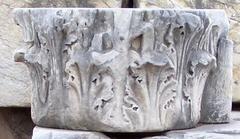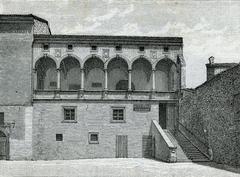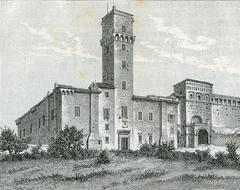Visiting the Arch of Augustus in Pesaro: History, Tickets, and Tips
Date: 23/07/2024
Introduction
The Arch of Augustus in Pesaro, Italy, stands as a monument to the grandeur and enduring legacy of the Roman Empire. Constructed in 9 BCE, this iconic arch was built to honor Emperor Augustus, the first Roman emperor who played a crucial role in transforming Rome from a republic to an empire. Augustus’s reign marked the beginning of the Pax Romana, a two-century-long period of relative peace and stability across the Roman Empire (source). The arch, strategically located at the entrance of Pesaro, served not only as a monumental gateway but also as a symbol of Rome’s architectural ingenuity and the emperor’s divine right to rule.
Architecturally, the Arch of Augustus is a quintessential example of Roman triumphal design, characterized by its use of classical orders, symmetry, and intricate decorations. It features a single, large central passage flanked by two smaller side passages, a design that later inspired other Roman triumphal arches. The inscriptions and reliefs on the arch celebrate Augustus’s achievements and military victories, reinforcing his legacy and the might of the Roman Empire (source).
Over the centuries, the arch has undergone several restoration efforts to preserve its structural integrity and historical value. Today, it stands as a significant cultural landmark, attracting scholars, historians, and tourists from around the world. Visitors to the Arch of Augustus can explore its rich history, architectural beauty, and cultural significance, making it a must-see destination in Pesaro (source).
Table of Contents
History of the Arch of Augustus
Origins and Construction
Constructed in 9 BCE, the Arch of Augustus was built to honor Emperor Augustus, who played a pivotal role in the expansion and consolidation of the Roman Empire. The arch was strategically placed at the entrance of the city, serving as a monumental gateway that symbolized the power and grandeur of Rome.
Architectural Design
The Arch of Augustus is a quintessential example of Roman architecture, characterized by its use of the classical orders and symmetry. Primarily made of local limestone, the arch features a single, large central passage flanked by two smaller side passages. This design was later emulated in other Roman triumphal arches.
Inscriptions and Decorations
One of the most striking features of the Arch of Augustus is its inscriptions. The arch bears a Latin inscription that dedicates the monument to Augustus, celebrating his achievements and contributions to the Roman state. The inscription reads, “IMP. CAESARI DIVI F. AVGVSTO COS. XIII TRIB. POT. XXX,” which translates to “To Imperator Caesar Augustus, son of the divine, consul for the thirteenth time, with tribunician power for the thirtieth time.”
The arch was also adorned with various decorative elements, including reliefs and sculptures that depicted scenes from Roman mythology and Augustus’s military victories. These decorations not only served an aesthetic purpose but also conveyed the emperor’s divine right to rule and his military prowess.
Historical Significance
The Arch of Augustus holds immense historical significance as it marks a period of relative peace and stability known as the Pax Romana. This era, initiated by Augustus, lasted for over two centuries and was characterized by economic prosperity, cultural flourishing, and territorial expansion. The arch stands as a testament to Augustus’s successful reign and the enduring legacy of the Roman Empire.
Preservation and Restoration
Over the centuries, the Arch of Augustus has undergone several restoration efforts to preserve its structural integrity and historical value. The first major restoration took place in the 18th century, spearheaded by local authorities who recognized the arch’s cultural importance. More recently, in the 20th and 21st centuries, advanced conservation techniques have been employed to ensure the arch remains a prominent historical landmark.
Archaeological Discoveries
Archaeological excavations around the Arch of Augustus have unearthed various artifacts that provide insights into the daily life and culture of ancient Pesaro. These discoveries include pottery, coins, and tools, which are now housed in local museums. The excavations have also revealed the original road that passed through the arch, offering a glimpse into the infrastructure and urban planning of Roman cities.
Cultural Impact
The Arch of Augustus has had a lasting impact on the cultural and historical identity of Pesaro. It is a focal point for local festivals and events, particularly those celebrating Roman history and heritage. The arch also attracts scholars, historians, and tourists from around the world, contributing to the city’s cultural tourism industry.
Modern-Day Relevance
Today, the Arch of Augustus stands as a symbol of Pesaro’s rich historical past and its connection to the broader narrative of the Roman Empire. The arch is a popular tourist attraction, drawing visitors who are eager to explore its historical significance and architectural beauty. Guided tours and informational plaques provide context and enhance the visitor experience, making the arch a must-see destination for history enthusiasts.
Visitor Information
Tickets and Hours
To visit the Arch of Augustus, there is no admission fee as it is an open public site. However, visitors are advised to check the Pesaro tourism website for the latest information on guided tours and special events.
Travel Tips
The arch is located in the heart of Pesaro, making it easily accessible by foot or public transportation. For those planning to visit, it is recommended to wear comfortable walking shoes and bring a camera to capture the architectural beauty. Additionally, exploring the surrounding area, which is home to other historical landmarks, cafes, and shops, can provide a fuller experience of Pesaro’s rich cultural heritage.
Special Events and Guided Tours
Special events and guided tours are often organized at the Arch of Augustus, especially during local festivals and historical celebrations. These tours provide deeper insights into the history and significance of the monument. Details about these events can be found on the Pesaro tourism website.
FAQ
What is the historical significance of the Arch of Augustus?
The Arch of Augustus marks a period of relative peace and stability known as the Pax Romana, initiated by Emperor Augustus. It stands as a testament to his successful reign and the enduring legacy of the Roman Empire.
What are the visiting hours for the Arch of Augustus?
The Arch of Augustus is accessible at all times as it is located in a public area. For guided tours and special events, check the Pesaro tourism website for the latest information.
Are there any nearby attractions?
Yes, the area surrounding the Arch of Augustus is rich with historical landmarks, cafes, and shops. Visitors can explore other Roman sites and enjoy the vibrant local culture.
Conclusion
The Arch of Augustus in Pesaro is more than just an architectural marvel; it is a historical monument that encapsulates the grandeur and legacy of the Roman Empire. Its rich history, intricate design, and cultural significance make it a fascinating subject of study and a must-visit destination for anyone interested in ancient history and Roman architecture.
For more detailed information, you can visit the official Pesaro tourism website or consult scholarly articles available on JSTOR.
References
- Discover the Arch of Augustus in Pesaro - History, Visiting Hours, and Travel Tips. (2024). Pesaro Tourism. source
- Exploring the Arch of Augustus in Pesaro, Italy - History, Significance, and Visitor Tips. (2024). Pesaro Tourism. source
- Ultimate Guide to Visiting the Arch of Augustus in Pesaro - Hours, Tickets, and Tips. (2024). Pesaro Tourism. source
- Official Tourism Website of Pesaro. (2024). Pesaro Tourism. source
- Viator. (2024). Pesaro Tourism. source
- GetYourGuide. (2024). Pesaro Tourism. source




